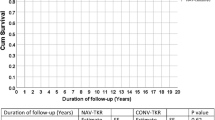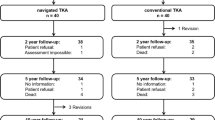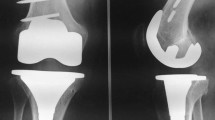Abstract
Computer navigation assistance in total knee arthroplasty (TKA) results in consistently accurate alignment of prostheses. We aimed to compare the outcome of computer-navigated and conventional TKA and to analyse the radiologically malaligned knees. We analysed 637 primary TKA, carried out by a single surgeon, over five consecutive years and divided them into two cohorts: group 1 = STA (standard instrumentation) and group 2 = CAS (computer-assisted surgery). There was no significant difference between the average Oxford Knee Scores (OKS) of the two groups at any time from one to five years. However, the malaligned TKA at three years had a worse OKS. At medium term there is no difference in clinical outcome measures that can be attributed to the surgeon having used computer-assisted navigation for TKA. But group 1, having a higher proportion of malaligned TKA, might show worsening of OKS at long term.
Résumé
La navigation dans la prothèse totale du genou permet d’avoir une amélioration de l’alignement articulaire. Nous avons comparé le devenir d’une prothèse totale du genou naviguée, ou traitée par voie conventionnelle, avec une analyse radiologique des genoux présentant une déviation externe en valgus. Nous avons analysé 637 prothèses totales du genou, réalisées par le même chirurgien sur 5 ans et divisées en deux groupes: le groupe 1 STA avec une instrumentation standard et le groupe 2 CAS avec navigation. Il n’y a pas de différence significative au niveau des scores d’Oxford (OKS) dans les deux groupes sur une période de 1 à 5 ans. Cependant, les genoux présentant un défaut d’axe post-opératoire ont un résultat OKS dégradé au bout de la troisième année. A moyen terme, il n’y a pas de différence sur le devenir clinique mais le groupe 1 a néanmoins une proportion beaucoup plus importante de genoux présentant une déviation axiale ce qui peut influer, de façon négative sur le score OKS à long terme.

Similar content being viewed by others
References
Bäthis H, Perlick L, Tingart M et al (2004) Alignment in total knee arthroplasty. A comparison of computer-assisted surgery with the conventional technique. J Bone Joint Surg Br 86(5):682–687
Bejek Z, Sólyom L, Szendrõi M (2007) Experiences with computer navigated total knee arthroplasty. Int Orthop 31(5):617–622
Bolognesi M, Hofmann A (2005) Computer navigation versus standard instrumentation for TKA: a single-surgeon experience. Clin Orthop Relat Res 440:162–169
Chauhan S, Clark G, Lloyd S, Scott R et al (2004) Computer-assisted total knee replacement. A controlled cadaver study using a multi-parameter quantitative CT assessment of alignment (the Perth CT Protocol). J Bone Joint Surg Br 86(6):818–823
Davies AP (2002) Rating systems for total knee replacement. Knee 9(4):261–266
Dawson J, Fitzpatrick R, Murray D et al (1998) Questionnaire on the perceptions of patients about total knee replacement. J Bone Joint Surg Br 80(1):63–69
Dunbar MJ, Robertsson O, Ryd L, Lidgren L (2001) Appropriate questionnaires for knee arthroplasty. Results of a survey of 3600 patients from The Swedish Knee Arthroplasty Registry. J Bone Joint Surg Br 83(3):339–344
Fehring TK, Mason JB, Moskal J, Pollock DC, Mann J, Williams VJ (2006) When computer-assisted knee replacement is the best alternative. Clin Orthop Relat Res 452:132–136
Field RE, Cronin MD, Singh PJ (2005) The Oxford hip scores for primary and revision hip replacement. J Bone Joint Surg Br 87(5):618–622
Haaker R, Stockheim M, Kamp M et al (2005) Computer-assisted navigation increases precision of component placement in total knee arthroplasty. Clin Orthop Relat Res 433:152–159
Jeffery RS, Morris RW, Denham RA (1991) Coronal alignment after total knee replacement. J Bone Joint Surg Br 73:709–714
Liow RY, Walker K, Wajid MA et al (2003) Functional rating for knee arthroplasty: comparison of three scoring systems. Orthopedics 26(2):143–149
Maculé-Beneyto F, Hernández-Vaquero D, Segur-Vilalta JM et al (2006) Navigation in total knee arthroplasty. A multicenter study. Int Orthop 30(6):536–540
Martin A, von Strempel A (2006) Two-year outcomes of computed tomography-based and computed tomography free navigation for total knee arthroplasties. Clin Orthop Relat Res 449:275–282
Matsumoto T, Tsumura N, Kurosaka M et al (2006) Clinical values in computer-assisted total knee arthroplasty. Orthopedics 29:1115–1120
Rand JA, Coventry MB (1988) Ten-year evaluation of geometric total knee arthroplasty. Clin Orthop Relat Res 232:168–173
Ritter MA, Faris PM, Keating EM, Meding JB (1994) Postoperative alignment of total knee replacement. Its effect on survival. Clin Orthop Relat Res 299:153–156
Spencer JM, Chauhan SK, Sloan K, Taylor A, Beaver RJ (2007) Computer navigation versus conventional total knee replacement: no difference in functional results at two years. J Bone Joint Surg Br 89(4):477–480
Stulberg SD (2003) How accurate is current TKR instrumentation? Clin Orthop Relat Res 416:177–184
Acknowledgements
Mrs. June Riordan, Outcomes Programme Co-Ordinator, St. Helier Hospital and Mr. Pradeep B. Moonot, Clinical Research Fellow, The South West London Elective Orthopaedic Centre.
Author information
Authors and Affiliations
Corresponding author
Rights and permissions
About this article
Cite this article
Kamat, Y.D., Aurakzai, K.M., Adhikari, A.R. et al. Does computer navigation in total knee arthroplasty improve patient outcome at midterm follow-up?. International Orthopaedics (SICOT) 33, 1567–1570 (2009). https://doi.org/10.1007/s00264-008-0690-0
Received:
Revised:
Accepted:
Published:
Issue Date:
DOI: https://doi.org/10.1007/s00264-008-0690-0




